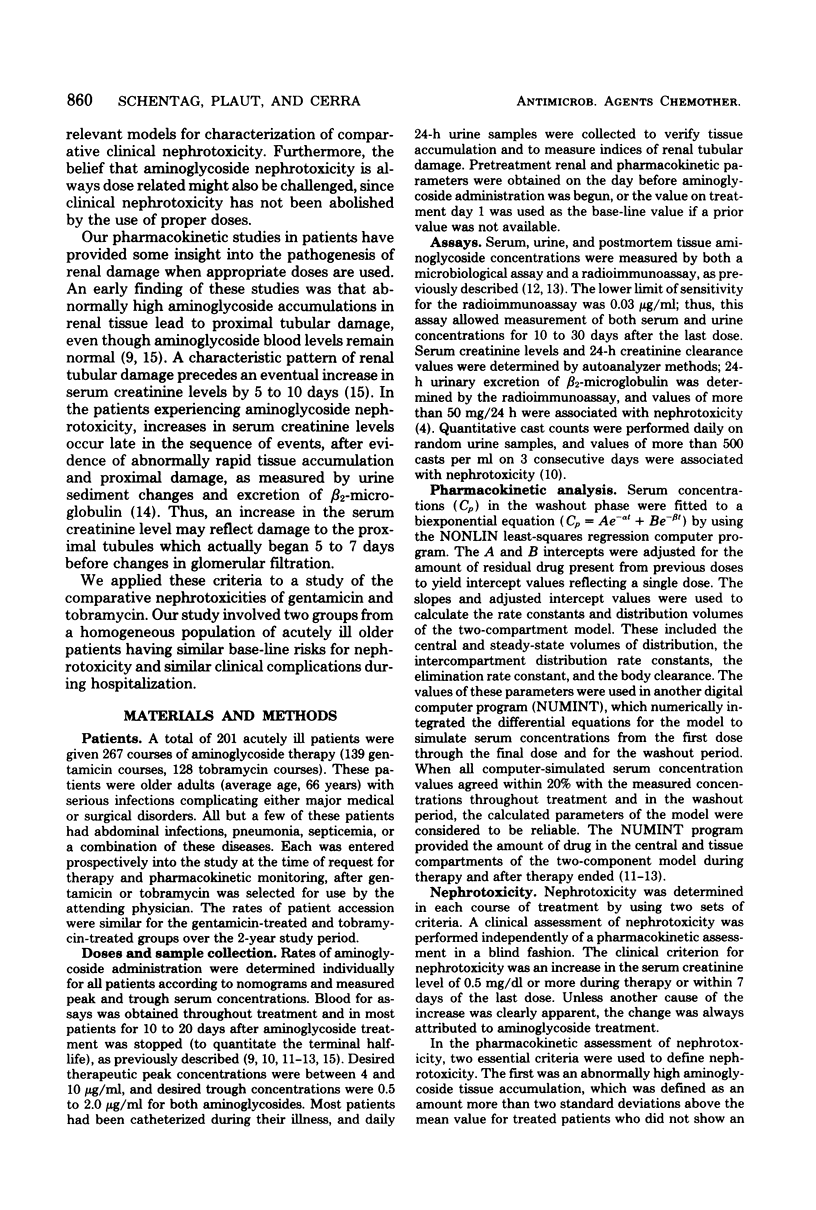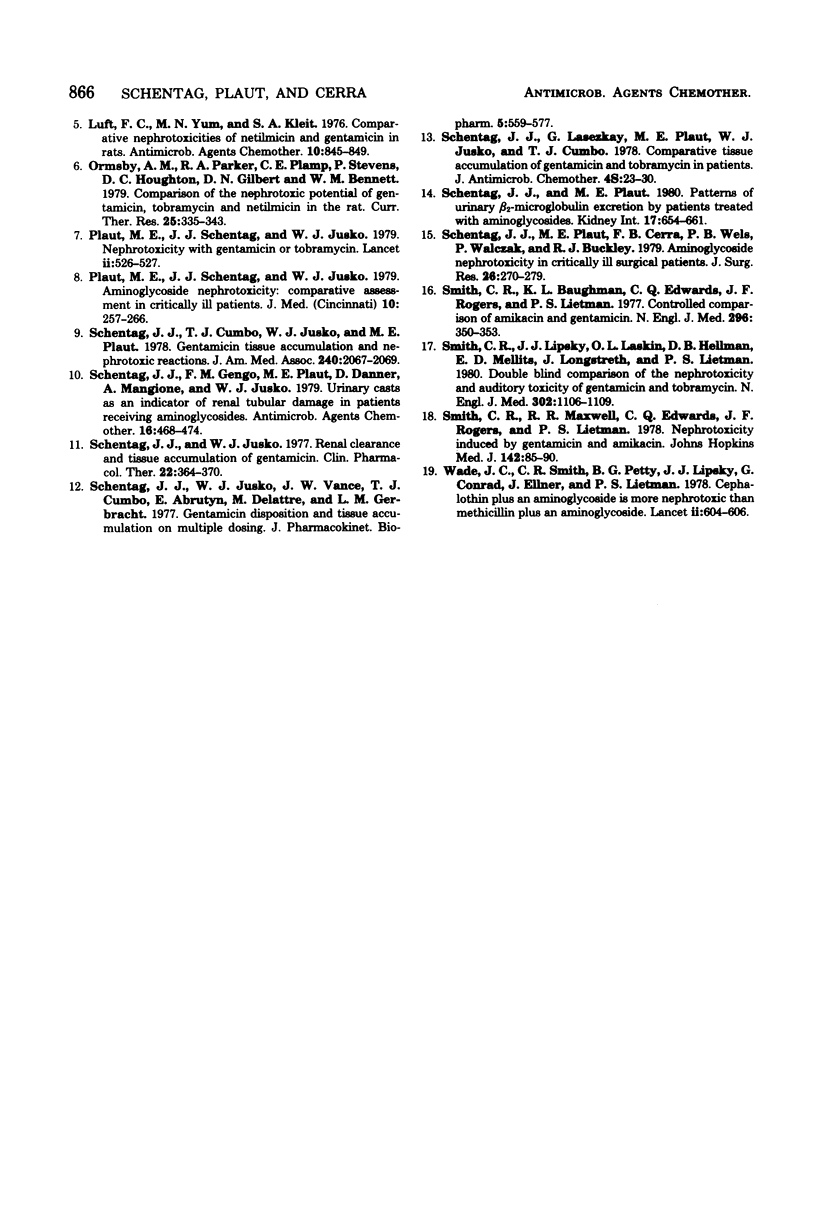Abstract
A total of 201 critically ill patients were studied during 267 courses of gentamicin or tobramycin treatment (139 gentamicin courses and 128 tobramycin courses). Of these 267 courses, pharmacokinetic and clinical data were obtained for 240 (120 gentamicin and 120 tobramycin). The data collected for pharmacokinetic analysis included measurements of serial blood and urine levels, urinary excretion of beta 2-microglobulin, protein levels, and granular casts. A two-compartment model was used to assess tissue accumulation, and in 89 courses the predicted accumulation was confirmed by cumulative urine collection or postmortem tissue analysis. As groups, the patients given gentamicin and tobramycin did not differ in age, weight, creatine clearance, total dose given, duration of treatment, initial aminoglycoside through serum levels, number of dosage adjustments, concurrent use of furosemide, or concurrent cephalosporins. Previous aminoglycoside treatment (usually gentamicin) had occurred more frequently in the tobramycin treated patients (P less than 0.01), and more males than females received tobramycin (P less than 0.05). Pharmacokinetic assessments of renal damage were based on both changes in glomerular filtration rate (serum creatinine levels, creatinine clearance) and renal tubular damage (beta 2-microglobin, casts), but only patients with elevated aminoglycoside tissue levels leading to renal tubular damage and subsequent creatinine clearance decreases were considered to have experienced aminoglycoside nephrotoxicity. In the pharmacokinetic analysis of nephrotoxicity, 29 gentamicin courses (24%) and 12 tobramycin courses (10%) were complicated by nephrotoxicity (P less than 0.01). The 201 study patients were also evaluated independently for clinical nephrotoxicity (defined as a serum creatinine level increase of 0.5 mg/dl or more). Clinical nephrotoxicity occurred at rates of 37% in the gentamicin-treated group and 22% in the tobramycin-treated group (P less than 0.02). In these similar groups of critically ill patients, tobramycin was less nephrotic than gentamicin.
Full text
PDF







Selected References
These references are in PubMed. This may not be the complete list of references from this article.
- Barza M., Lauermann M. Why monitor serum levels of gentamicin? Clin Pharmacokinet. 1978 May-Jun;3(3):202–215. doi: 10.2165/00003088-197803030-00002. [DOI] [PubMed] [Google Scholar]
- Fee W. E., Jr Aminoglycoside ototoxicity in the human. Laryngoscope. 1980 Oct;90(10 Pt 2 Suppl 24):1–19. doi: 10.1288/00005537-198010001-00001. [DOI] [PubMed] [Google Scholar]
- Gilbert D. N., Plamp C., Starr P., Bennet W. M., Houghton D. C., Porter G. Comparative nephrotoxicity of gentamicin and tobramycin in rats. Antimicrob Agents Chemother. 1978 Jan;13(1):34–40. doi: 10.1128/aac.13.1.34. [DOI] [PMC free article] [PubMed] [Google Scholar]
- Hewitt W. L. Gentamicin: toxicity in perspective. Postgrad Med J. 1974 Nov;50 (Suppl 7):55–61. [PubMed] [Google Scholar]
- Luft F. C., Yum M. N., Kleit S. A. Comparative nephrotoxicities of netilmicin and gentamicin in rats. Antimicrob Agents Chemother. 1976 Nov;10(5):845–849. doi: 10.1128/aac.10.5.845. [DOI] [PMC free article] [PubMed] [Google Scholar]
- Plaut M. E., Schentag J. J., Jusko W. J. Aminoglycoside nephrotoxicity: comparative assessment in critically ill patients. J Med. 1979;10(4):257–266. [PubMed] [Google Scholar]
- Plaut M. E., Schentag J. J., Jusko W. J. Nephrotoxicity with gentamicin or tobramycin. Lancet. 1979 Sep 8;2(8141):526–527. doi: 10.1016/s0140-6736(79)91580-0. [DOI] [PubMed] [Google Scholar]
- Schentag J. J., Cumbo T. J., Jusko W. J., Plaut M. E. Gentamicin tissue accumulation and nephrotoxic reactions. JAMA. 1978 Nov 3;240(19):2067–2069. [PubMed] [Google Scholar]
- Schentag J. J., Gengo F. M., Plaut M. E., Danner D., Mangione A., Jusko W. J. Urinary casts as an indicator of renal tubular damage in patients receiving aminoglycosides. Antimicrob Agents Chemother. 1979 Oct;16(4):468–474. doi: 10.1128/aac.16.4.468. [DOI] [PMC free article] [PubMed] [Google Scholar]
- Schentag J. J., Jusko W. J. Renal clearance and tissue accumulation of gentamicin. Clin Pharmacol Ther. 1977 Sep;22(3):364–370. doi: 10.1002/cpt1977223364. [DOI] [PubMed] [Google Scholar]
- Schentag J. J., Jusko W. J., Vance J. W., Cumbo T. J., Abrutyn E., DeLattre M., Gerbracht L. M. Gentamicin disposition and tissue accumulation on multiple dosing. J Pharmacokinet Biopharm. 1977 Dec;5(6):559–577. doi: 10.1007/BF01059684. [DOI] [PubMed] [Google Scholar]
- Schentag J. J., Lasezkay G., Plaut M. E., Jusko W. J., Cumbo T. J. Comparative tissue accumulation of gentamicin and tobramycin in patients. J Antimicrob Chemother. 1978 May;4 (Suppl A):23–30. doi: 10.1093/jac/4.suppl_a.23. [DOI] [PubMed] [Google Scholar]
- Schentag J. J., Plaut M. E. Patterns of urinary beta 2-microglobulin excretion by patients treated with aminoglycosides. Kidney Int. 1980 May;17(5):654–661. doi: 10.1038/ki.1980.77. [DOI] [PubMed] [Google Scholar]
- Smith C. R., Baughman K. L., Edwards C. Q., Rogers J. F., Lietman P. S. Controlled comparison of amikacin and gentamicin. N Engl J Med. 1977 Feb 17;296(7):349–353. doi: 10.1056/NEJM197702172960701. [DOI] [PubMed] [Google Scholar]
- Smith C. R., Lipsky J. J., Laskin O. L., Hellmann D. B., Mellits E. D., Longstreth J., Lietman P. S. Double-blind comparison of the nephrotoxicity and auditory toxicity of gentamicin and tobramycin. N Engl J Med. 1980 May 15;302(20):1106–1109. doi: 10.1056/NEJM198005153022002. [DOI] [PubMed] [Google Scholar]
- Smith C. R., Maxwell R. R., Edwards C. Q., Rogers J. F., Lietman P. S. Nephrotoxicity induced by gentamicin and amikacin. Johns Hopkins Med J. 1978 Mar;142(3):85–90. [PubMed] [Google Scholar]
- Wade J. C., Smith C. R., Petty B. G., Lipsky J. J., Conrad G., Ellner J., Lietman P. S. Cephalothin plus an aminoglycoside is more nephrotoxic than methicillin plus an aminoglycoside. Lancet. 1978 Sep 16;2(8090):604–606. doi: 10.1016/s0140-6736(78)92825-8. [DOI] [PubMed] [Google Scholar]


